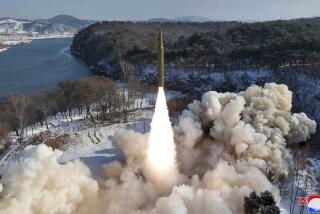Northrop Laser Shows Promise
- Share via
Northrop Grumman Corp. engineers working in secrecy at Edwards Air Force Base successfully tested a high-energy, chemical laser Wednesday, bolstering prospects for a controversial airborne missile defense system.
The laser, designed to eventually be mounted on a 747 jumbo jet, is one of the centerpieces of the Bush administration’s plans for a layered missile-defense system of air, ground and sea-based weapons. Boeing Co. is the prime contractor on the missile-defense system, with Northrop in charge of the laser development.
Although the laser test barely lasted a second, it marked the first time that a chemical laser had created a beam of light. Over the next few months, engineers hope to increase the duration and energy of the laser’s beam so it could shoot down a ballistic missile from more than 200 miles away.
Pentagon officials envision using the laser to destroy a missile shortly after being launched from North Korea or another nation as a laser-armed 747 flies at 40,000 feet.
But critics have assailed the so-called Airborne Laser as too technologically challenging. Congress last month put Boeing and Northrop on notice that the laser program might be canceled, citing numerous delays and cost overruns. Since the laser program began in 1996, the original $3.6-billion contract has ballooned to more than $5 billion.
An official with the Missile Defense Agency, an arm of the Pentagon that is developing the system, confirmed the successful laser test Thursday.
“It lasted only a fraction of a second, but the important thing is we got the photons, which proves the laser works,” said Ken Englade of the agency’s Airborne Laser program. “It came at a very good time, because people were saying it wasn’t going to work.”
“This is the best news they’ve had in a very long time,” said Philip Coyle, a former Pentagon chief for testing and a critic of missile defense systems. “They still have a long way to go, but this is a big milestone.”
U.S. military officials have been trying to develop a laser powerful enough to shoot down a missile from a long distance but compact enough to fit in an aircraft. Until this week, laser beams capable of destroying objects from a distance could be generated only using chambers that would fill a 15-story building.
The laser beam generated Wednesday came from a mixture of chemicals encased in modules about the size of six Chevy Suburbans, installed in the fuselage of a 747.
After further ground tests of this chemical oxygen-iodine laser, it will be reinstalled in a 747 jet that has been modified with a laser-firing turret. Much of the laser development work has been done by Northrop engineers in Redondo Beach.
But a number of technical hurdles still remain.
Even if the technology challenges are overcome, critics have raised concerns that bad weather could disrupt the accuracy of the laser. The large 747 aircraft could also be vulnerable to attack, they said.
More to Read
Inside the business of entertainment
The Wide Shot brings you news, analysis and insights on everything from streaming wars to production — and what it all means for the future.
You may occasionally receive promotional content from the Los Angeles Times.










